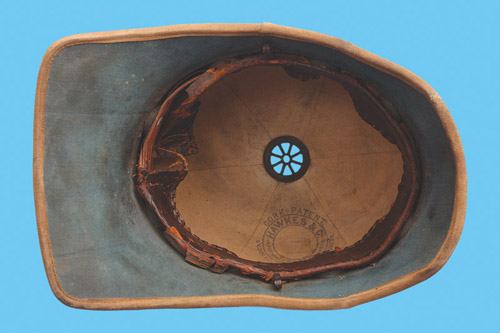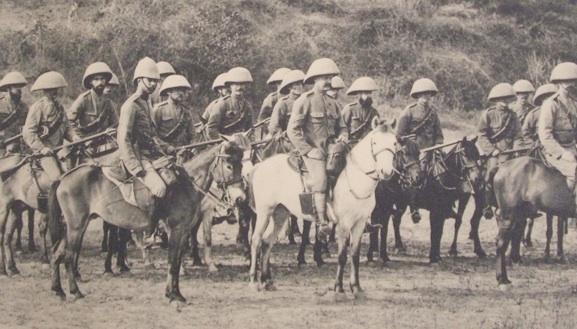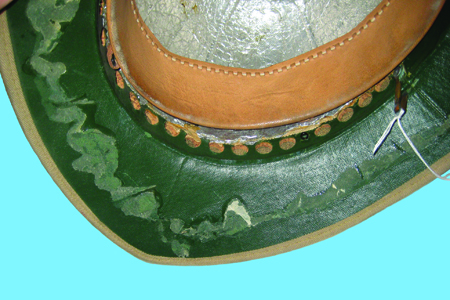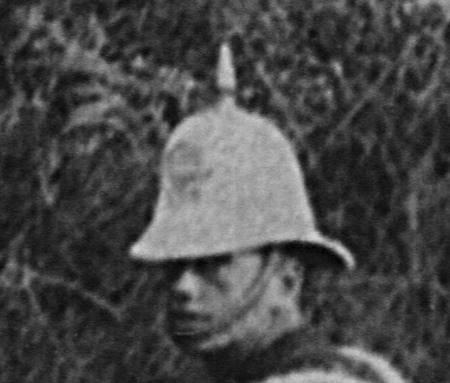
1st Battalion Northamptonshire Regiment c1892 wearing experimental helmets developed in the late 1880s. (Photo courtesy Michael Barthorp)
Since being introduced into the British Army in the late 1870s several problems with the Colonial pattern helmet prompted a search for a replacement. Those problems were; the rear of the helmet forcing the front peak down thereby making firing a rifle in the prone position difficult, and the lack of sun protection to the temples. There are many period photographs showing the helmets being worn back to front to provide better sun protection to the eyes although, therefore, exposing the neck.
This experimental helmet, shown above as issued to the Northamptonshire Regiment, was also issued to several other regiments and lasted in use until at least 1896. It appears to have been worn only on home service.
Another experimental helmet appeared around 1896 and two examples are known to exist. This example is dated 1896 and unusually for a Hawkes & Co. helmet for Other Ranks contains the maker’s stamp.
This helmet does not appear to address any of the problems with the Colonial Pattern and was not taken into service. To this author it has a decidedly Germanic appearance which was not well received by the troops.

Note the removal of the ventilator cap and the side rosettes which would have been removed for re-use. (Author’s collection)

The interior showing the Hawkes stamp. The helmet also has the WD stamp over 1896. (Author’s collection)
Yet another experimental hat, but probably without official sanction, was the so-called Colind hat. The below illustration was taken from the Osprey book North West Frontier by Robert Wilkinson-Latham.
The “Colind” hat, which was apparently common enough in India, was constructed of straw and cloth covered. As Robert Wilkinson-Latham says “Though practical, it was – for obvious reasons – never popular.” He goes on to say that this piece of headgear was “invented” by Henry Hart of Oxford Street, London. However, a search of the London trade directories reveals no such manufacturer, and according to Chris Mills (The Jaunty Hat) it may have been confusion between George Hart of Regent Street, London and Henry Heath of Oxford St, London.

A mounted Infantry section of the Norfolk Regiment stationed at Mandalay, Burma, in the 1890s, riding their little Burmese ponies, trying out greater mushroom sola topees. (The Jaunty Hat)

In fact this style was very reminiscent of the Planters’ hat, worn very early in the 19th Century by planters who spent long periods of time in the sun. It was popular with Corps of Royal Engineers and with some of the Army Chaplains.
The helmet worn by General Graham above, whilst not truly an experimental version, is possibly important because of it similarities to the later universal British Wolseley pattern helmet.
The Wolseley pattern helmet was in use from around 1896 but in an unofficial capacity and for officers only. It first made its appearance in the Dress Regulations for the Army in 1900. It was also subject to some experimental versions. The example below has as visor which covers several ventilation holes covered by a mesh to prevent the incursion of insects.

This helmet also features many glue spots which may have secured a fly-mesh to the underside of the brim. (Courtesy of the York Castle Museum)

The mesh covered ventilation holes and the glue spots where a fly veil may have been fitted. (Courtesy of the York Castle Museum)
Stuart Bates





